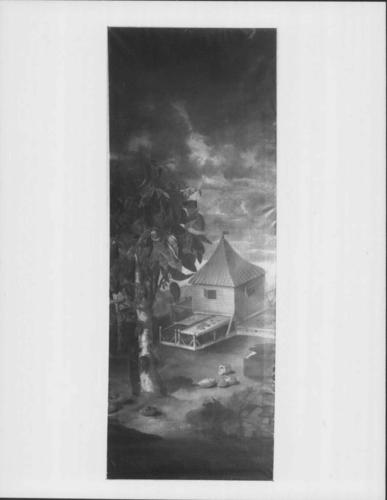A Cocoa Tree and Roasting Hut c.1672
Oil on canvas | 277.0 x 103.5 cm (support, canvas/panel/stretcher external) | RCIN 406104
-
This painting depicts the process used in growing and preparing cocoa or cacao in the Caribbean in the later 17th century. A farm building with a red tiled roof has cocoa beans drying trays on all sides with the pods drying on them; in the left foreground is a cocoa tree, the trunk and branches covered with pods, some of which are lying on the ground.
The picture was attributed to Albert Eckhout in Christopher White’s catalogue of Dutch Paintings in the Collection of HM The Queen, first published in 1982 (No 53); it was then believed to have been painted in Brazil and associated with the large views of Cleves thought to have once hung in the residence of the former Governor General of the Dutch colony of Brazil, Prince Johan of Nassau-Siegen. These views entered the collection in the reign of Charles II.
Research by Rupert Goulding and Philip Emanuel into an almost identical painting in the collection at Dyrham Park (NT 453749) in 2021 revealed that the Royal Collection painting was almost certainly completed in Jamaica and presented to Charles II in 1672 (Arts, Buildings and Collections Bulletin, Autumn 2021 pp 5-9). The Dyrham Park version is believed to have been painted in London, and although they were very close in size (the Royal Collection painting has been extended), the rich red of the cocoa beans and D hooks appear more convincing in the Royal Collection version, suggesting this is the original. This is coupled with the fact that it was proposed that on showing the picture to the king, if he should like it, it should be presented to him.
There is evidence that the painting was sent after 2 March 1672, and travelled aboard Royal Africa Company Ship Diligence, commanded by Captain Cullen. A letter written for Lieutenant Governor of Jamaica, Sir Thomas Lynch to Sir Robert Moray, a fellow of the Royal Society, recounted that Lynch instructed Cullen to deliver a report on Jamaica –at that time the Island was producing an abundance of sugar, but no cocoa or cacao. Cullen returned with, amongst other things, ‘A Box marked L that has in it a Cocoa Tree painted to the Life’. An accompanying letter described in great detail the manner of drying and curing the contents of the large ovoid pods to produce a substance that was ‘agreeable to the Palet’. The tree depicted was said to have been part of the cacao plantation at Sixteen Mile Walk in St Katherine’s parish owned by the former Governor of Jamaica, Sir Thomas Modyford. Here hundreds of enslaved Africans would have worked on the plantations, planting and harvesting this valuable commodity, although this is not mentioned in the account.
The painting was first recorded in Windsor in 1688 (entitled The Chocolate tree); it remained in Windsor for most of the 18th century and we believe in the early 20th century was enlarged at the top and bottom to incorporate it into a display with the views of Cleves on the staircase at Frogmore House, Windsor.Provenance
Presented to Charles II in 1672; first recorded in Windsor in 1688
-
Creator(s)
(nationality)Acquirer(s)
-
Medium and techniques
Oil on canvas
Measurements
277.0 x 103.5 cm (support, canvas/panel/stretcher external)
196.0 cm (support (etc), excluding additions)
300.0 x 125.1 x 6.6 cm (frame, external)
Category
Object type(s)
Subject(s)
Other number(s)
Alternative title(s)
A Landscape with a Farm Buildings in Brazil [previously entitled]









